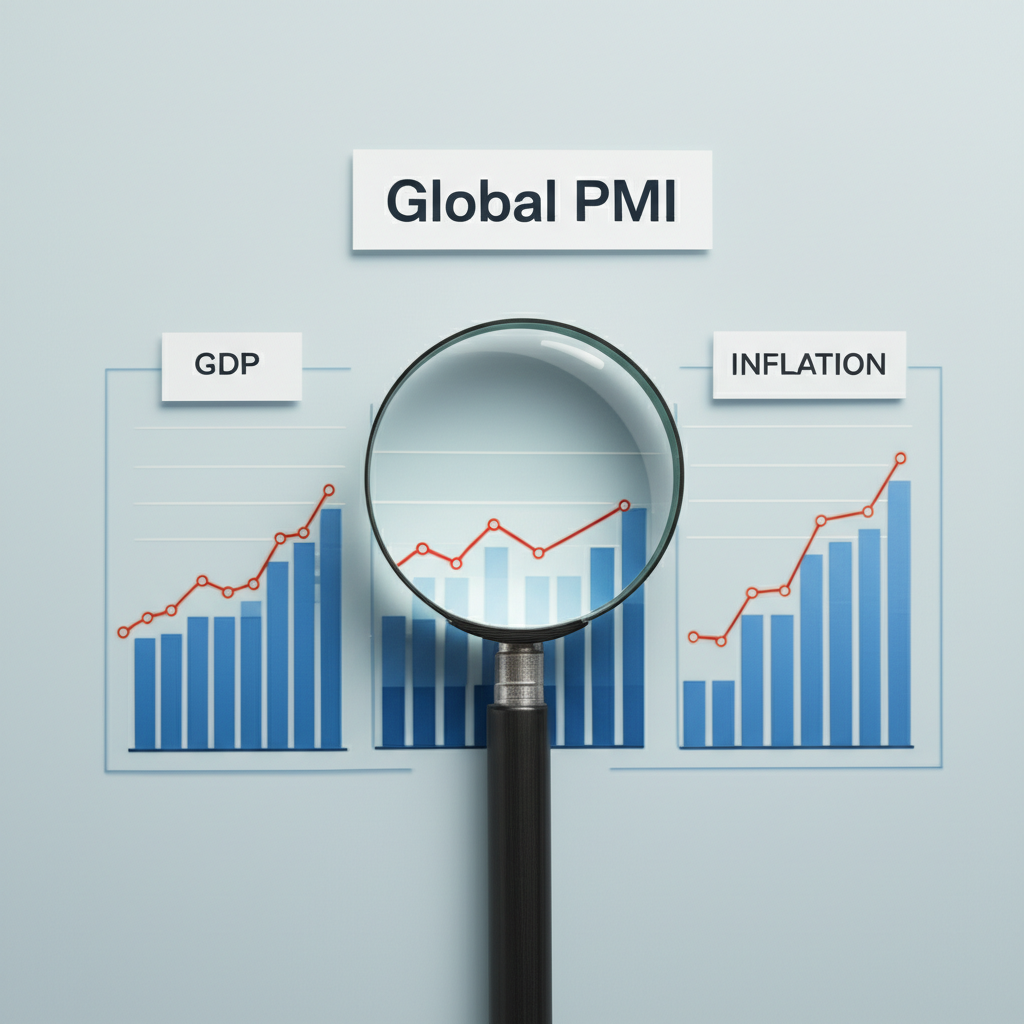Understanding PMI Components: Manufacturing, Services, and Composite Indices

The global economy operates like a vast, interconnected network where changes in one region ripple across continents. For businesses, investors, and policymakers navigating this dynamic terrain, the Global Purchasing Managers’ Index (PMI) serves as a vital navigational tool. More than just a statistical metric, the Global PMI functions as a real-time pulse check on worldwide economic activity, offering timely insights into shifts in production, demand, and employment.

As a leading economic indicator, the Global PMI often moves ahead of official data releases such as GDP or employment reports. Its forward-looking nature allows analysts to detect early signs of acceleration or slowdown in economic momentum. Because it’s based on monthly surveys of purchasing managers—individuals who directly manage supply chains and production—the index captures shifts in business sentiment before they fully materialize in broader macroeconomic figures. This makes the PMI an essential resource for strategic decision-making in finance, corporate planning, and public policy.

At its core, the Purchasing Managers’ Index is a diffusion index derived from survey responses, designed to reflect changes in business conditions compared to the prior month. To provide a comprehensive picture of economic performance, the PMI is segmented into three primary components:
- Manufacturing PMI: This tracks the health of the industrial sector by measuring key variables such as new orders, output levels, employment, supplier delivery times, and inventory holdings. A reading above 50 typically indicates expanding manufacturing activity, which can signal rising demand for raw materials, increased factory utilization, and stronger export potential. Conversely, a reading below 50 points to contraction, often linked to weakening consumer demand, supply chain disruptions, or overstocking issues.
- Services PMI: Given that services dominate the economic structure of most developed nations, this index is crucial for assessing trends in consumer spending, business services, and labor markets. It evaluates changes in business activity, new client acquisition, staffing levels, and pricing dynamics. Strong services performance often correlates with resilient domestic demand and stable job growth, making it a key barometer of overall economic vitality.
- Composite PMI: By combining both manufacturing and services data—usually weighted by each sector’s share of GDP—the Composite PMI delivers the most holistic view of private sector activity. It smooths out sector-specific volatility and offers a clearer signal of whether an economy is broadly expanding or contracting. Analysts rely heavily on this index when identifying turning points in the business cycle, especially during periods of transition between growth and recession.
Together, these indices form a multi-dimensional framework for evaluating economic conditions across countries and regions. Their interplay reveals not only overall trends but also structural imbalances—such as a strong services sector masking manufacturing weakness—that might otherwise go unnoticed.
Deconstructing the Global PMI Index: Methodology and Key Data Providers

The reliability and widespread acceptance of the Global PMI stem from its rigorous, standardized methodology. Each month, S&P Global—a leading provider of financial intelligence—conducts surveys among purchasing and supply chain managers across private sector companies in over 40 countries. These individuals are uniquely positioned to observe shifts in demand, pricing pressures, and logistical challenges firsthand.
Participants are asked to report whether specific business indicators have improved, deteriorated, or remained unchanged compared to the previous month. The five core components evaluated are:
- New Orders: Reflects the volume of incoming demand for goods or services, serving as a leading signal of future production levels.
- Output / Business Activity: Measures actual production output in manufacturing or service delivery in non-manufacturing sectors.
- Employment: Tracks changes in workforce size, offering insight into labor market trends and business confidence.
- Suppliers’ Delivery Times (Manufacturing) / Backlogs of Work (Services): Longer delivery times may indicate supply constraints or high demand; rising backlogs suggest increasing pressure on service providers.
- Stocks of Purchases (Manufacturing) / Input Prices (Services): Monitors inventory levels or cost pressures from raw materials and inputs, providing early warnings of inflationary or deflationary trends.
Responses are converted into diffusion indices, where each component is scored based on the percentage of respondents reporting improvement minus those reporting decline. These scores are then weighted and aggregated to produce the final PMI figure. A key advantage of this approach is its timeliness—data is typically released within the first week of the following month, far earlier than government statistics.
S&P Global stands as the primary global source for PMI data, maintaining consistency in survey design and coverage across economies. This enables meaningful cross-country comparisons and supports macro-level analysis of regional and global trends. For instance, their Composite PMI for the Eurozone is widely cited by central banks and financial institutions.
In parallel, the Institute for Supply Management (ISM) publishes influential PMI reports for the United States, focusing on both manufacturing and non-manufacturing sectors. While ISM and S&P Global use similar conceptual frameworks, differences exist in sample selection, sector weighting, and seasonal adjustment techniques. As a result, their U.S. readings may diverge slightly month to month. However, both series generally align in direction and trend, reinforcing their credibility among market participants.
How to Interpret PMI Readings: The Critical 50-Point Threshold and Beyond
Interpreting the PMI hinges on understanding the significance of the 50-point benchmark. This threshold separates expansion from contraction:
- PMI above 50: Indicates that the majority of surveyed firms experienced improving conditions, signaling sector-wide expansion. The further above 50, the stronger the pace of growth—for example, a jump from 52 to 56 suggests accelerating momentum.
- PMI below 50: Suggests more firms reported declines than improvements, indicating contraction. A drop from 49 to 45 reflects a deepening downturn, while a rise from 44 to 48 implies the rate of decline is slowing—a possible precursor to stabilization.
- PMI at 50: Points to no net change in business conditions, though it doesn’t necessarily mean stagnation—it could reflect offsetting forces within the sector.
Beyond the headline number, analysts scrutinize the underlying subcomponents to uncover drivers behind the trend. For example, a rising New Orders index with flat Employment may suggest companies are managing demand through efficiency gains rather than hiring. Similarly, elevated Input Prices can foreshadow inflationary pressure even if overall activity remains subdued.
Trends over time matter as much as absolute levels. A consistent string of readings above 50 builds confidence in sustained growth, while repeated dips below 50 raise red flags about recession risks. Moreover, divergences between manufacturing and services PMIs can reveal structural shifts—such as a post-pandemic rebound in travel and leisure outpacing industrial output.
Global PMI Index by Country: Current Performance and Key Regional Trends
Tracking PMI data across major economies offers granular insights into the state of the world economy. Recent trends show a fragmented landscape, with some regions showing resilience amid ongoing inflation, geopolitical uncertainty, and monetary tightening.
The table below illustrates the latest PMI performance across key economies (note: figures are illustrative and reflect recent trends; actual data should be sourced from S&P Global or ISM):
| Country/Region | Latest Manufacturing PMI | Latest Services PMI | Latest Composite PMI | Trend (Month-over-Month) |
|---|---|---|---|---|
| United States | ~50.5 | ~52.0 | ~51.8 | Slightly improving growth |
| Eurozone | ~47.5 | ~51.5 | ~50.8 | Services driving modest expansion |
| China | ~50.3 | ~54.0 | ~53.5 | Steady expansion, services robust |
| Japan | ~49.0 | ~52.5 | ~52.0 | Manufacturing contraction, services strong |
| United Kingdom | ~48.0 | ~53.0 | ~52.5 | Services expansion offsetting manufacturing weakness |
| India | ~58.0 | ~60.0 | ~59.5 | Robust and accelerating growth |
(Note: Figures are illustrative and represent hypothetical recent trends. Real-time data would vary and should be sourced directly from S&P Global or ISM.)
Notable patterns emerge from this data. In the Eurozone, persistent energy costs and weaker external demand have kept manufacturing in contraction, yet domestic-driven services activity has maintained overall economic stability. Meanwhile, China’s gradual recovery post-pandemic has been fueled by a rebound in consumer-facing services, even as property sector challenges weigh on industrial output.
India stands out with strong momentum across both sectors, reflecting robust domestic demand, infrastructure investment, and favorable demographics. Japan, despite manufacturing headwinds due to yen depreciation and input cost pressures, benefits from a resurgence in tourism and digital services.
These disparities underscore the importance of regional context. A global composite reading may mask significant variations underneath—highlighting why investors and businesses must drill down into country-specific and sector-specific PMIs for accurate forecasting.
Global Manufacturing PMI Index: A Deep Dive into Industrial Activity
The Global Manufacturing PMI serves as a critical gauge of industrial momentum, reflecting the health of factories, supply chains, and global trade flows. Because manufacturing is highly sensitive to interest rates, consumer demand, and commodity prices, its PMI readings often act as a leading proxy for global economic sentiment.
When the index climbs above 50 and sustains gains, it typically signals increasing capital investment, rising exports, and stronger demand for raw materials like copper, steel, and oil. This can propel upward pressure on commodity prices and freight rates. For example, during the post-2020 recovery, the surge in global manufacturing activity contributed to record shipping costs and supply bottlenecks, reshaping logistics strategies worldwide.
Conversely, prolonged weakness in the manufacturing PMI often presages broader economic softness. Recent years have seen recurring headwinds: semiconductor shortages disrupted automotive production; geopolitical tensions affected energy supplies; and inflation eroded consumer purchasing power. These factors contributed to extended periods of contraction in manufacturing across Europe and parts of Asia.
Additionally, structural shifts such as supply chain diversification—driven by “friendshoring” or regionalization efforts—have altered trade patterns. Countries once reliant on centralized global suppliers are now investing in domestic capacity or nearshoring arrangements, influencing PMI dynamics differently across regions.
For stakeholders in manufacturing, logistics, or commodity markets, tracking this index provides early warning signals. A sustained pickup in new orders, for instance, may justify expanding production capacity or securing long-term supplier contracts. On the other hand, declining employment or rising inventory levels could prompt inventory rationalization or operational restructuring.
Historical Global PMI Data: Lessons from Past Economic Cycles
Historical analysis of PMI data reveals its consistent track record as a harbinger of economic turning points. Over decades, sharp drops in the Global Composite PMI have preceded or coincided with major recessions, offering valuable lead time for corrective action.
During the 2008–2009 Global Financial Crisis, the Global Composite PMI plunged below 40, reflecting a collapse in demand, credit contraction, and widespread factory shutdowns. Similarly, in early 2020, the index crashed to historic lows as pandemic lockdowns brought global commerce to a near halt. In both cases, the PMI bottomed out before official GDP figures confirmed the depth of the downturn—demonstrating its role as a real-time diagnostic tool.
Equally telling is its ability to signal recoveries. After the 2020 plunge, the PMI rebounded rapidly, surpassing 55 within months, foreshadowing a powerful but uneven recovery driven by fiscal stimulus and pent-up demand. A similar rebound occurred after the 2009 crisis, albeit more gradual.
Historical comparisons also highlight how policy responses influence PMI trajectories. Central bank interventions, stimulus packages, and targeted support for affected sectors have all played roles in shaping the speed and strength of PMI rebounds.
Moreover, visualizing PMI trends alongside GDP growth over the past two decades shows a strong positive correlation. Periods of sustained PMI expansion align closely with rising global output, while prolonged contractions precede economic slowdowns. This predictive power makes the index indispensable for economists and strategists seeking to anticipate macroeconomic shifts.
The Global PMI as a Leading Economic Indicator: Predictive Power and Limitations
The Global PMI is widely recognized as one of the most reliable leading indicators due to its timeliness and sensitivity to changing business conditions. Because purchasing managers are directly involved in ordering, production, and hiring decisions, their assessments reflect real-time operational realities—often weeks before official statistics become available.
Its predictive value extends to several key macroeconomic variables:
- GDP Growth: Rising PMI readings typically precede stronger quarterly GDP growth, while falling readings often flag upcoming slowdowns. Studies have shown a strong statistical relationship between PMI trends and subsequent GDP performance across major economies.
- Inflation: The ‘Prices Paid’ sub-index tracks changes in input costs. When this component rises steadily—especially amid expanding activity—it often heralds broader inflationary pressures. Central banks monitor this closely when setting interest rates.
- Employment: Changes in the Employment sub-component frequently precede official labor market data. A sustained increase suggests businesses are hiring in anticipation of higher demand, while declines may signal looming layoffs.
Despite its strengths, the PMI has limitations. It is based on qualitative survey responses, meaning it captures sentiment and perception rather than hard output data. While highly correlated with actual economic outcomes, it doesn’t measure the exact magnitude of change. For example, a PMI of 52 indicates expansion, but not whether GDP will grow by 1% or 3%.
Additionally, the index focuses exclusively on the private sector and excludes government activity and informal economies. It may underrepresent small businesses depending on survey sampling, and short-term volatility can sometimes distort long-term trends.
Therefore, while the PMI provides a powerful early signal, it should be used in conjunction with other indicators such as industrial production, retail sales, employment reports, and consumer confidence surveys to form a complete economic picture.
PMI and Financial Markets: Impact on Investment Decisions and Asset Classes
Financial markets react swiftly to PMI releases, especially when data surprises expectations. Traders and portfolio managers use these figures to reassess economic outlooks, adjust risk exposure, and anticipate central bank actions.
Key market implications include:
- Equities: Strong PMI readings boost investor confidence in corporate earnings potential, particularly in cyclical sectors like industrials, materials, and consumer discretionary. Conversely, weak data can trigger sell-offs, especially if it suggests a recession is looming. Sector-specific PMIs help refine allocation—for example, a rising Services PMI may favor tech or financial stocks.
- Fixed Income (Bonds): Bond yields tend to rise on strong PMI prints, as markets price in higher growth and inflation, increasing expectations of rate hikes. Weaker readings, however, often lead to yield declines as investors seek safety and anticipate monetary easing.
- Currency Exchange Rates: Currencies of countries with strong PMI performance typically appreciate, reflecting healthier economic fundamentals and tighter monetary policy prospects. For example, better-than-expected U.S. PMI data often strengthens the dollar against peers like the euro or yen.
- Commodity Prices:

留言